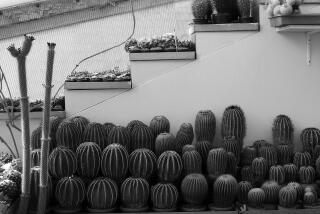The Prickly Problem : Cacti Are Easy to Collect, as Individual as Stamps and Coins-- but Tricky to Organize
- Share via
ALL COLLECTORS HAVE a common problem--that of organization. But when the collectible is cactus, things get to be particularly prickly. There are hundreds of these spiny succulents, and it is quite possible to amass a considerable number in just a short time. Soon the question arises of what to do with them.
Although all cacti are similar to one another, each is an individual, much like stamps and coins are; that is what makes them collectible. Most do not get to be very large, and most can be grown in pots, which makes them easy to collect. However, unlike stamps and coins, cacti are alive and growing, and they need sunshine, water, fertilizer and other attentions. All of this complicates their organization and display, enough so that many plant collectors simply don’t try.
The two cactus collections seen on these pages are remarkably well organized, although their owners would probably feel a little uncomfortable with the notion that collecting consists merely of acquisition and display. Seymour Linden, president of the Cactus and Succulent Society of America, takes his collecting seriously, managing his plants as though they were in a botanical garden. Taxonomy, or the naming of plants, is the key to the way Linden organizes his cacti. All are neatly arranged by genus, the first name in a botanical name-- Oreocereus of Oreocereus trollii , for instance. The plants in a given genus are supposedly similar, at least botanically, so that brings some logic to a collection. But culturally they can vary greatly, some needing more (or less) water or sun. So then he groups the cactus plants according to their care requirements; all are carefully labeled.
Linden says, partly in jest, that he would rather lose a plant than a label, because knowing the correct identity of a plant is essential to its survival. How can you tell whether Oreocereus trollii is extinct or not if no one knows precisely what he or she has? Conservation is of great concern to serious cactus collectors. They now frown on people who pick up cacti from the wild, since so many plants have been taken. Linden has given many of his rarer cactus plants to commercial nurseries so that they can be propagated and distributed to other nurseries. Propagated plants are then put into gardens, which is certainly one way of preserving a plant that is endangered in its native habitat. Indeed, there are already some cacti that exist only in gardens.
Linden’s collection is not only intelligently organized, it is also attractively displayed. That reflects both his fondness for cacti and some experience in art--he dabbled in sculpture before becoming involved with cacti. Shelves are built into the railing of his hillside deck--an attractive solution to the problem of displaying so many plants in pots. But some of Linden’s best arrangements are simply clusters of similar-looking plants.
A basic rule of design dictates that a grouping of objects that look alike tends to please the eye.
Joe Heiferman is not that interested in the scientific side of the cactus, but he is no less passionate about growing them. He displays cactus plants as though they were gemstones in fine settings. That follows, because Heiferman is in the jewelry business, and before he discovered cacti he collected rocks and crystals. Many rocks from his previous collection are scattered through the beds of cacti.
About half of the Heiferman cactus collection grows in pots that sit on specially constructed shelves. The plants must be turned regularly to ensure that all sides receive sun and light. Some cacti are planted in rather unusual containers--at least for cacti. Hanging from the fences are baskets made of wire that have been lined with green moss, filled with soil and then planted with cacti rather than the more usual flowers. Because cacti do not need to be watered as often as other plants, they are easy to care for. And although growing them in baskets helps make the mandatory fences around the swimming pool more attractive, Heiferman was glad to find yet another spot to grow cacti in a garden already becoming crowded with his specimens.
Cacti also grow in the ground in both the Heiferman and Linden gardens. However, the plants are found only in raised beds filled with specially prepared soil. In the Heiferman garden, several of the raised beds were built on top of the paving that surrounds the pool--a clever way of turning paved areas into garden areas without having to tear out paving. This works only with cacti because they have rather shallow root systems and they don’t need a deep soil. Water exits through the sides of the raised beds. And, of course, the soil mixture is one that drains exceptionally well, since cacti can’t bear a wet or soggy soil.






